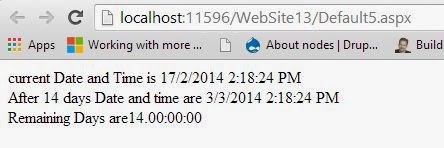Source Code
<%@ Page Language="C#" AutoEventWireup="true" CodeFile="Default5.aspx.cs" Inherits="Default5" %><!DOCTYPE html PUBLIC "-//W3C//DTD XHTML 1.0 Transitional//EN" "http://www.w3.org/TR/xhtml1/DTD/xhtml1-transitional.dtd">
<html xmlns="http://www.w3.org/1999/xhtml">
<head runat="server">
<title></title>
</head>
<body>
<form id="form1" runat="server">
<div>
<asp:Label ID="Label1" runat="server" Text=""></asp:Label>
</div>
</form>
</body>
</html>
//Code behind code
using System;
using System.Collections.Generic;
using System.Linq;
using System.Web;
using System.Web.UI;
using System.Web.UI.WebControls;
public partial class Default5 : System.Web.UI.Page
{
protected void Page_Load(object sender, EventArgs e)
{
DateTime currenttime = DateTime.Now;
DateTime after14days = currenttime.AddDays(14);
TimeSpan ts = after14days - currenttime;
Label1.Text += "current Date and Time is " + currenttime.ToString () + "<br/>";
Label1.Text += "After 14 days Date and time are " + after14days+"<br/>";
Label1.Text += "Remaining Days are" + ts;
}
}

















